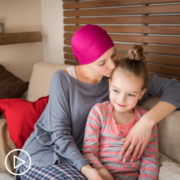What Do DLBCL Patients Need to Know About Treatment and Research?
What Do DLBCL Patients Need to Know About Treatment and Research? from Patient Empowerment Network on Vimeo.
How have diffuse large B-cell lymphoma (DLBCL) treatment options evolved? Lymphoma expert Dr. Matthew Matasar reviews current treatment options for DLBCL and shares his perspective on where research is heading.
Dr. Matthew Matasar is a lymphoma expert at Rutgers Cancer Institute. To learn more about Dr. Matasar, visit here.
See More From The Pro-Active DLBCL Patient Toolkit
Related Programs:

|

|

|
Transcript:
Katherine Banwell:
Dr. Matasar, what are the types of treatments currently available to treat DLBCL?
Dr. Matasar:
So, DLBCL, or diffuse large B-cell lymphoma, is the most common type of aggressive B-cell non-Hodgkin’s lymphoma in America and really around the world. Aggressive lymphomas are a double-edged sword. They tend to grow quickly over weeks to months, and they tend to make people feel sick if left untreated, but they’re potentially curable in many although not all patients.
We now have a growing body of treatment options available to maximize the changes of cure and to minimize short and long-term risks in patients diagnosed with aggressive B-cell lymphomas.
The first recent innovation is a treatment program that seems to improve upon the standard of care treatment called R-CHOP, R-C-H-O-P, which is a combination of chemotherapy and immunotherapies in the treatment of newly diagnosed diffuse large B-cell lymphoma. And this new regimen substitutes out one of those medicines, the O, which is a medicine called Oncovin, or vincristine, with a newer medicine that has a long name called polatuzumab vedotin, or pola for short. And we found in the recent Polarix trial was that by introducing this new pola medicine instead of the older Oncovin treatment, we’re able to lead to longer durations of remission for patients with newly diagnosed large cell lymphoma and is able to do so without any increase in short- or long-term side effects, which makes it a real win in my mind.
That’s one major innovation. The second is in patients who, unfortunately, have a relapse of their diffuse large B-cell lymphoma or whose disease does not go into remission after first treatments. We now know that patients who have an early relapse or have, what we call, primary refractory disease, meaning it didn’t go away after the first treatment at all, is we now have data using treatments that are calling CAR-T cell, or chimeric antigen receptor modified T-cell therapy. CAR-T cell therapy is a treatment in which we use your own body’s healthy T cells. Some of those are filtered out, and they are genetically re-engineered in way that trains them to attack lymphoma cells and then given back as a living treatment, as a mini-transfusion.
This CAR T-cell therapy was compared to a standard chemotherapy program that uses high dose therapy with stem-cell rescue or auto transplant, or stem cell transplants, for patients with this high-risk scenario, early relapse or primary refractory disease.
And what we found is that CAR T-cell therapy with either the treatment called axi-cel (Yescarta) or the treatment called liso-cel (Breyanzi),two different CAR-T therapies, were superior to the traditional chemotherapy and stem-cell transplant approach in these highest risk patients leading to marked improvements in outcomes in these patients and maybe even improving overall survival, which is a very high benchmark at this early time point in these two critical trials. So, improvements in newly diagnosed therapy and improvements for those patients who suffer early relapse or primary refractory disease mark two important advances in the care of patients with DLBCL.
Katherine Banwell:
What are you excited about when it comes to DLBCL treatment and research?
Dr. Matasar:
What I’m most excited about is our ability to improve outcomes in the highest risk patients. We often talk in academic circles about unmet need, which is just a silly way of saying we really wish we could do better. And there’s unmet need across the line when we think about how we take care of patients with aggressive B-cell lymphoma, newly diagnosed patients, patients who are newly diagnosed who may be older or more frail, who may need specialized treatment approaches, patients who suffer a relapse of this disease one or multiple times.
We cure many patients with diffuse large B-cell lymphoma, but many is not enough. And we’re not going to rest until we can have uniform and universal success and, unfortunately, we’re not there. But we’re working to get there day after day. The options are expanding. The trials are promising. Novel therapies are very exciting, and I really believe that these next years are going to see profound innovation and improvements in outcomes. That comes with clinical research and with patients being willing to trust doctors to participate in this journey together and doctors being willing to take a chance and offer patients novel therapies when we know that our current treatments are simply inadequate.










